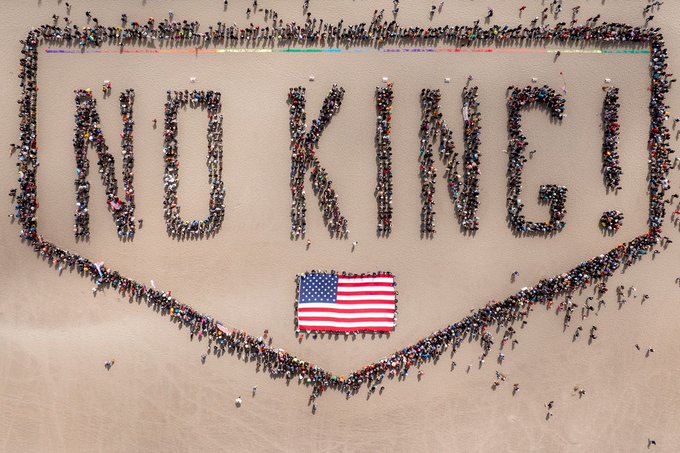Thousands marched in San Francisco on Trump’s birthday, protesting authoritarianism and immigration policies.

SAN FRANCISCO (WE) — On June 14, 2025—President Donald Trump’s 79th birthday—San Francisco erupted in coordinated protest as part of the nationwide “No Kings” movement. With thousands gathered at Mission Dolores Park, the city joined over 2,000 communities nationwide challenging what many see as authoritarian threats to American democracy.
The protest opposed militarized immigration enforcement, expanded presidential power, and Trump’s Army birthday parade, which marked the U.S. Army’s 250th anniversary in Washington, D.C.. Demonstrators also criticized the deployment of National Guard and U.S. Marines in response to civil unrest in Los Angeles.
Community organizer Michelle Magee, speaking for Indivisible San Francisco, said: “We believe in two fundamental values: we don’t have kings in the U.S., and we have the right to protest.”
Magee and Indivisible SF led the march from Dolores Park to Civic Center Plaza, backed by partner groups like the 50501 Movement and SEIU Local 1021. Organizers trained peace marshals to maintain calm. Colorful signs, satire, and costumes—some provocative—amplified their message. Early in the day, a massive human banner reading “No Kings!” appeared on Ocean Beach, visible from the air.
Law enforcement braced for the crowds. San Francisco Mayor Daniel Lurie and SFPD Chief Paul Yep assured residents the city would protect peaceful protests but crack down on violence. San Francisco Sheriff Paul Miyamoto added that jails were prepared and that transport vans were “ready to provide free rideshares straight to jail.”
Mayor Lurie emphasized that San Francisco does not cooperate with Immigration and Customs Enforcement (ICE). However, he warned that vandalism or violence would prompt arrests. “We welcome peaceful protest,” he said, “but we won’t tolerate criminal behavior.”
District Attorney Brooke Jenkins reinforced that point: “We draw the line at destruction. Charges will follow any violence, vandalism, or illegal activity.”
The San Francisco Department of Public Works prepped for clean-up. Spokesperson Rachel Gordon explained that while crews could sweep debris or provide plywood, property owners remain responsible for repairs. “If a window breaks, we’ll clear the glass,” she said. “But replacing it is up to the owner.”
Demonstrators assembled around 11:30 a.m. at Dolores Park, then marched through the Mission District toward Civic Center Plaza. In Oakland, protesters met at Wilma Chan Park before heading to Frank Ogawa Plaza, where speakers like Assemblymember Buffy Wicks and union leader Stewart Chen addressed the crowd.
Newsom Stands Against Trump’s Deportation Agenda as Immigration Battle Redefines 2026 Political Landscape: No Kings Protest Unites Thousands in San Francisco Against Authoritarianism
Cities throughout the Bay Area also joined. In Gilroy, organizers Cammie Brown and Whitney Pintello rallied about 200 participants. Brown said, “We see democracy under attack. We’re patriots trying to protect it.” Pintello added, “This isn’t about shouting—it’s about listening and building a better future.”
Their group, Women for Action, Voice and Equality (WAVE), has led smaller rallies throughout the Trump administration. Saturday’s turnout reflected growing urgency in farming communities like Gilroy, where immigrant families fear deportation and discrimination.
Nearby business owners mostly supported the protest. John Holder, owner of Brew City Burgers and Westside Grill, said demonstrators didn’t disrupt operations. “They come in, march, and then grab food,” he laughed.
Other towns held “No Kings” rallies too. Demonstrations took place in Morgan Hill, Boulder Creek, Santa Cruz, Salinas, and Aromas. Though small in size, these towns voiced strong resistance.
By midday, San Francisco crowds exceeded 3,000, with thousands more across the region. Rallies stretched from San Jose’s St. James Park to Walnut Creek and Berkeley. In Oakland, Mayor Barbara Lee joined marchers, reiterating, “We will not let democracy be dismantled.”
Governor Gavin Newsom deployed 700 California Highway Patrol officers across the state. The Office of Emergency Services also activated its teams. Their focus: protect protest rights and prevent chaos.
Fire Chief Dean Crispen monitored another issue—burning vehicles. In Los Angeles, demonstrators torched Waymo self-driving cars. With lithium-ion batteries posing fire risks, Crispen told crews not to extinguish certain vehicle fires unless safe to do so. In response, Waymo pulled vehicles from protest zones.
At a SoMa ICE office at 478 Tehama Street, over 100 protesters disrupted morning check-ins. Chants like “Down with ICE” echoed as many immigrants arrived for asylum appointments. Attorney Priya Patel of the California Collaborative for Immigrant Justice said her clients feared arrest but joined the rally anyway.
This wasn’t the first clash with authorities. A week earlier, police arrested over 200 people in violent skirmishes. Two officers suffered injuries after objects were thrown. Buildings and cars were damaged, prompting stricter enforcement protocols for Saturday.
Despite the high stakes, this weekend’s protests stayed peaceful. Organizers credit coordination between groups and trained peacekeepers. Law enforcement kept a watchful but restrained presence. No major incidents were reported in San Francisco or Oakland.
Protests also broke out in other cities: Los Angeles, Santa Cruz, Little Rock, Fayetteville, and Mobile, Alabama all saw marches under the “No Kings” banner. Protesters raised alarms about rising authoritarianism and the erosion of civil rights.
The intelligence community monitored closely. Reports suggest that citizen-created ICE tracking tools now face scrutiny from the U.S. Army and other federal agencies. Officials fear these tools could be misused by “malicious actors.”
Saturday’s event in the Bay Area marked one of the largest protest collaborations since the George Floyd protests. From human banners on beaches to chants in public parks, the demonstrations sent a clear message: Americans will not accept authoritarian rule.
By evening, city crews began cleanup. Public Works removed signs and graffiti. Downtown stores pulled down plywood. Protesters helped de-escalate tensions before dispersing.
But beyond logistics, the march delivered something deeper: a civic revival. The people of San Francisco and the greater Bay Area made their stance unmistakably clear. They marched not just against Trump, ICE, or military parades—but for democracy itself.
They marched because, as they chanted across cities and towns, “We the People have no king.”